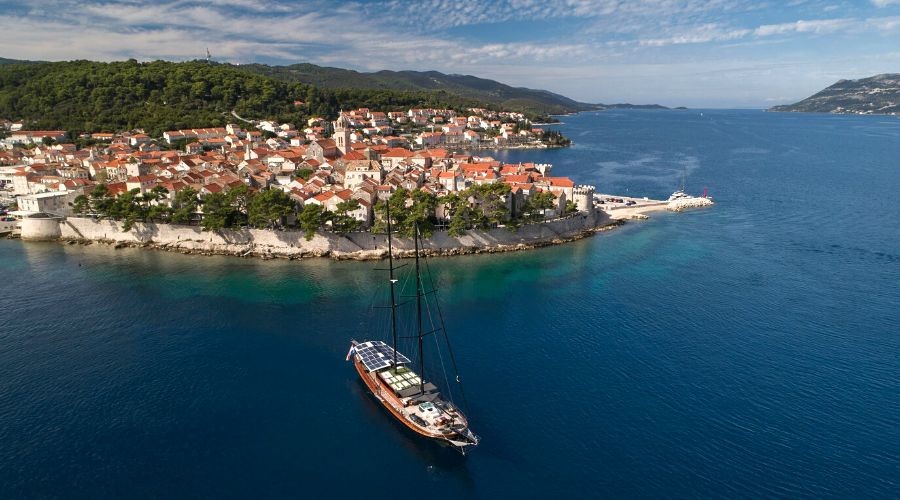
For first-time charterers in Croatia, we have prepared a guide that will help you get an idea of what can be visited in 7 days on the most popular sailing route - from Split to Dubrovnik. Our expert team is there to help create the perfect sailing vacation with tailor-made suggestions just for you!
Croatia is a country with a rich history and culture; the old towns, monuments, people, and traditions are the ambassadors of its unique history. It also has 10 UNESCO World Heritage sites and 15 sites and monuments on the ‘Tentative’ List. Many of these sites can be visited during a sailing holiday in Croatia. The beauty of Croatia only enhances your sailing experience and it’s no surprise why the Adriatic Coast today is a hotspot for sailing holidays and charter guests in the summer months.
DAY 1. Split - Brač
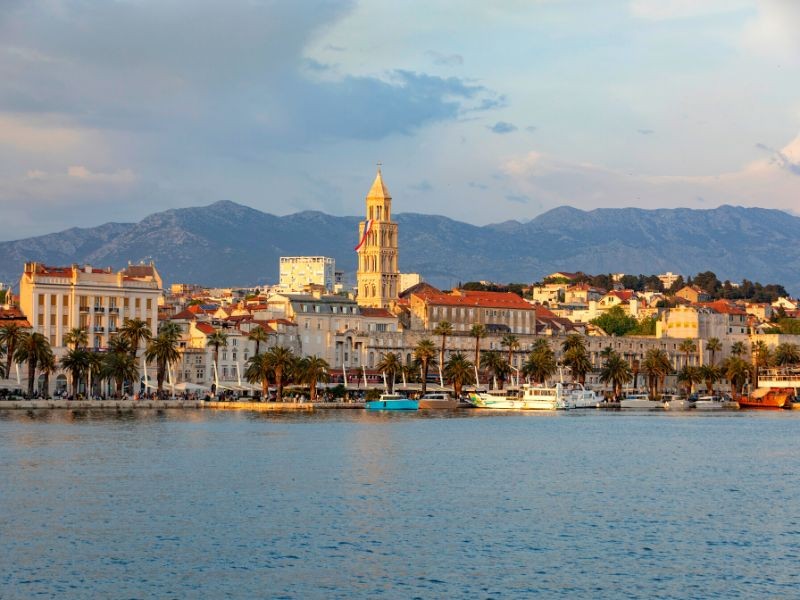
Before you embark on your boat, you should definitely take a walk and explore the Old city of town Split! The oldest part of Split is set in the Roman Palace dating back to the early 4th century. Roman emperor Diocletian built the palace, as his retirement home. Today the main hub to the central Dalmatian islands and Croatian coastal towns, Split quickly rose to fame as one of Croatia’s most popular tourist destinations.
If you are interested in discovering history and architecture, we suggest you visit:
- The Cathedral of Saint Dominus (patron saint of Split) & Peristyle (central square of the Palace).
- Vestibule and Temple of Jupiter City squares (Prokurative, Pjaca, Voćni trg/Fruit square).
- Mestrovic Gallery
- Drink a coffee on Vidilica, with a view of the whole town.
- Take a walk on Riva, the main promenade.
- Blend in with the locals and feel the rhythm of this amazing town!
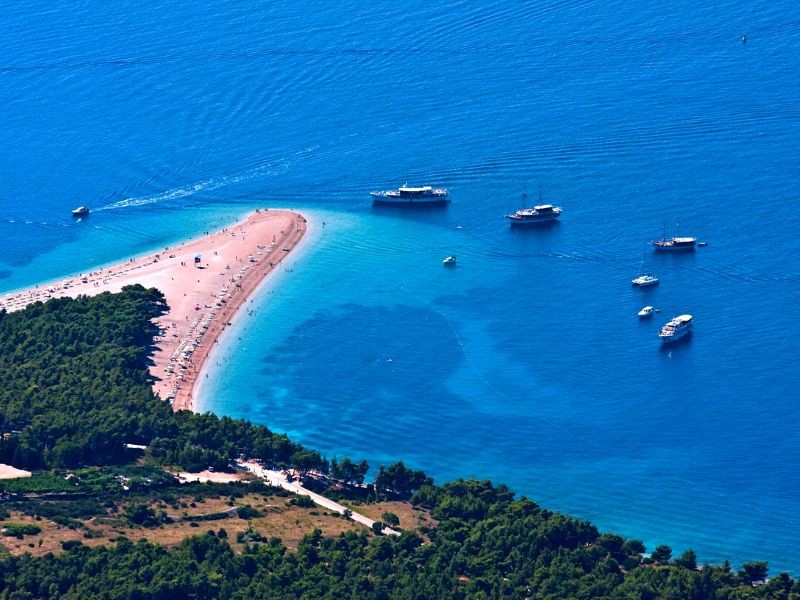
Despite its proximity to Split, Brač is less touristy than the glittering islands of Hvar and Korčula further south. Brač is most well-known for its famous Zlatni Rat beach, the poster child for Croatian tourism; however, this is just the tip of the iceberg or in this case – the beach. From magical bays to stunning nature, rich history and tradition, to the weird and wonderful, Brač will delight and surprise all travelers who take the time to get to know this island. Covered in cypress trees, olive groves, and vineyards, it is a lush green paradise begging to be explored.
We recommend visiting:
- The olive oil museum - in Škrip, a museum was opened in 2014 in a building that housed an oil mill. The building was restored and today visitors are guided through to see a piece of history.
- Taste local wine Stina - white wine (Pošip) and red wine (Plavac Mali) are available with quite a few options for both are there are a number of grape varieties in Brač.
- Stop by Škrip - Škrip is completely different from the coastal towns of Brač Island, there’s no hustle and bustle, just cool history, old buildings, and a few museums to explain the town and islands' history.
- Visit the Stonemasonry School - in Pučišća you can visit the Stonemasonry school to be truly blown away by the amount of work and incredible details that go into stonemasonry.
- Blaca Monastery - the cave was originally where monks sought solitude and as a place of protection after fleeing from the Turks. The monks then built the monastery around the cave which can still be visited to this day.
DAY 2. Brač - Hvar
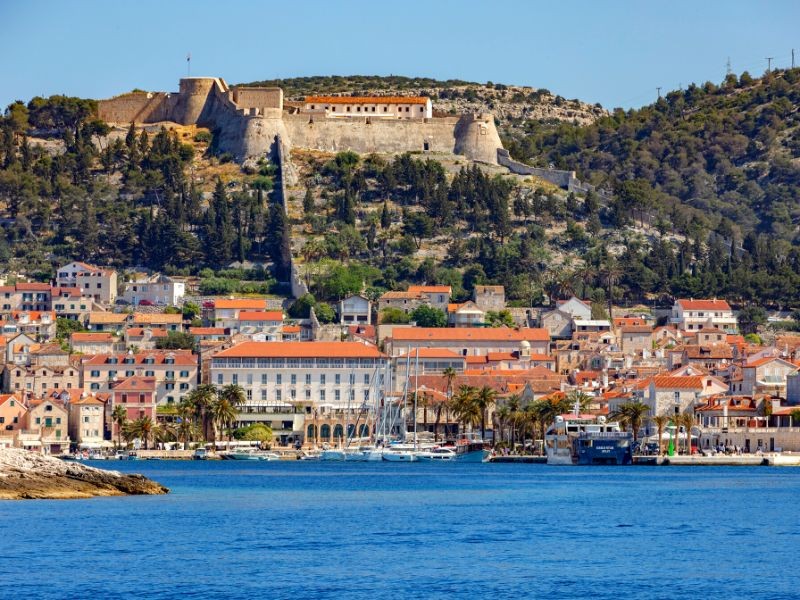
Hvar, often alluded to as the "Santorini" of Croatia, due to its much-photographed Venetian architecture, offers a mix of culture and a vibrant restaurant and café life. Hvar is undoubtedly the Adriatic’s most popular summer hotspot. From the posh party haven of Hvar town to the smaller island gems that bring us back to the origins of its authenticity, this island knows no bounds and has something for all types of travelers, no matter their generation.
What to do in Hvar?
- Walk around and discover the center of the city (St.Stephen Cathedral & Square, Arsenal, Venetian Loggia, and Clock Tower).
- Zipp around with a scooter and discover inland of the island.
- Hike up to the Fortica fortress and enjoy beautiful views.
- Dine in authentic surroundings.
- Taste some of the best Croatian wines, for which this island is famous.
For guided tours we recommend:
- Hvar Wine Tasting Tour - don’t miss a chance to try Plavac Mali, which is the most indigenous grape in Dalmatian Region.
- Lavender Tour includes an expert guide to take you through the aromatic fields, where you will learn the harsh realities of life in Dalmatia before tourism.
- Cycling Tour that combines pleasure and workout to explore the island!
DAY 3. Hvar - Korčula
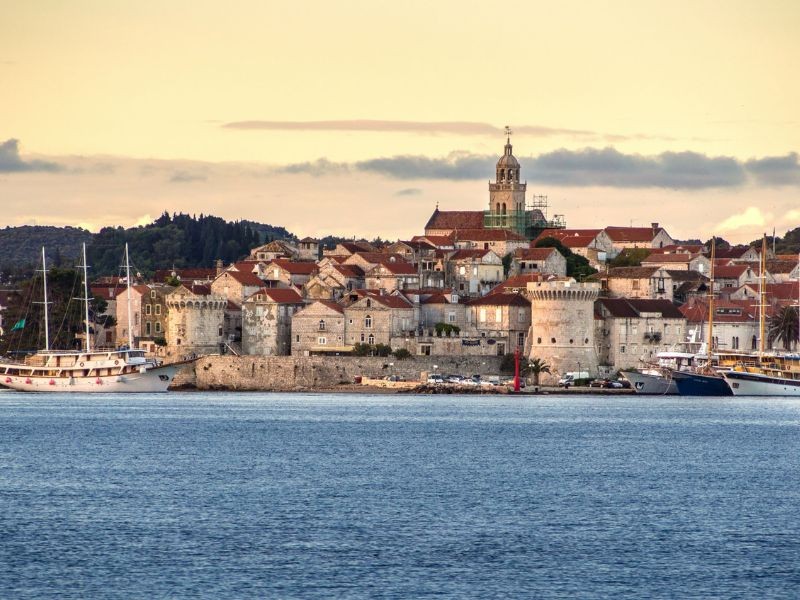
Known for its dense forest, this wooded island was named by ancient Greeks (Korkyra Melaina, meaning black Korkyra). Often considered to be one of the most beautiful cities in Croatia due to its medieval towers and walls which surround the whole center of the town. Korčula is a “must go to” place while sailing these areas. It is lit up by local life, quaint villages, and fertile fields. It is a fantasy destination for foodies and history buffs. But more than all, it is a sanctuary for sailors.
Tours and activities we recommend for when in Korčula:
- Wine tasting Tour - visit one or more of the various wineries and sample delicious local wines, especially white wines such as Grk, Rukatac, and Pošip.
- Korčula Old Town Tour - learn about history and architecture with a local guide, and visit various museums, churches, Marco Polo’s house, and St. Mark’s Cathedral.
- Mountain Bike Tour - discover inland and small villages with a professional tour guide.
- Rent a buggy or car - discover new places on your own.
- Listen to live music - numerous bars & restaurants offer live performances nightly, from modern covers to traditional Croatian folk music and the beautiful harmony of a local Klapa (a cappella) group.
DAY 4. Korčula - Mljet
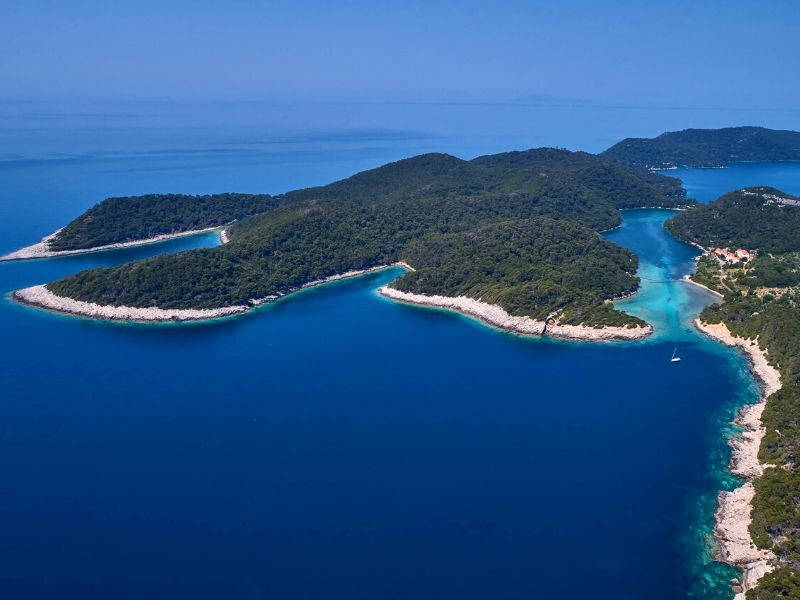
The island of Mljet is the most beautiful and most forested island in the Adriatic, and one of the most beautiful pearls of the Mediterranean. Situated on the island of the same name, Mljet National Park is the most important protected area of the Dalmatian south. The park includes two deep bays which, due to their extremely narrow links with the sea, are regarded as and indeed named lakes: the Great Lake and the Small Lake. Besides NP, there are a few small towns hidden among oak and pine trees. With beautiful scenery, crystal clear sea, saltwater lakes, limestone and dolomite cliffs, and karst valleys, Mljet is a pure paradise and one of Mother Nature’s finest creations.
What to do in Mljet?
- Walking & hiking - if you love spending your time outdoors.
- Cycling - for more active visitors, we suggest renting bikes and exploring the island on two wheels. If interested, you can bring bathing suits and jump into the lakes and enjoy your afternoon in nature.
- Visit Odysseus Cave - which you can enter from the sea by a small boat. There are also many other attractive and lovely caves such as Ostasevica and Morvica which are parts of the mountain in the center of the island.
DAY 5. Mljet - Šipan
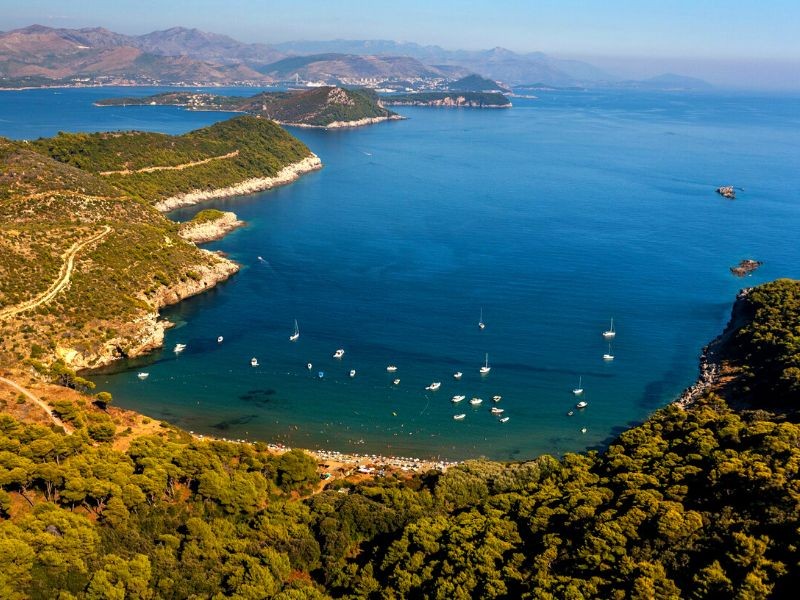
Šipan is the largest island in the Elaphite archipelago and boasts two port villages - Suđurađ (a port located on the eastern part of the island) and Šipanska (situated to the west). Given that these two towns are the largest on the island, one can expect restaurants, cafes, and shops - and should you want to explore them both, they’re only 5 km apart on land. And consider yourself lucky, because Šipan is the only island that allows cars!
When in Šipan we recommend:
- Visiting Stjepović Skoćibuha castle and tower, Pakljena Benedictine monastery, and St. Mary’s Church.
- Hiking from Šipanska luka to Velji Vrh. If you’re on a trip with your kids, Šipan is a perfect place for you to be active. The island is pretty quiet with very low traffic, and all hiking and cycling trails are easy and pretty Safe.
- Cycling in Šipansko Polje valley between Šipanska Luka and Suđurađ.
DAY 6. Šipan - Dubrovnik
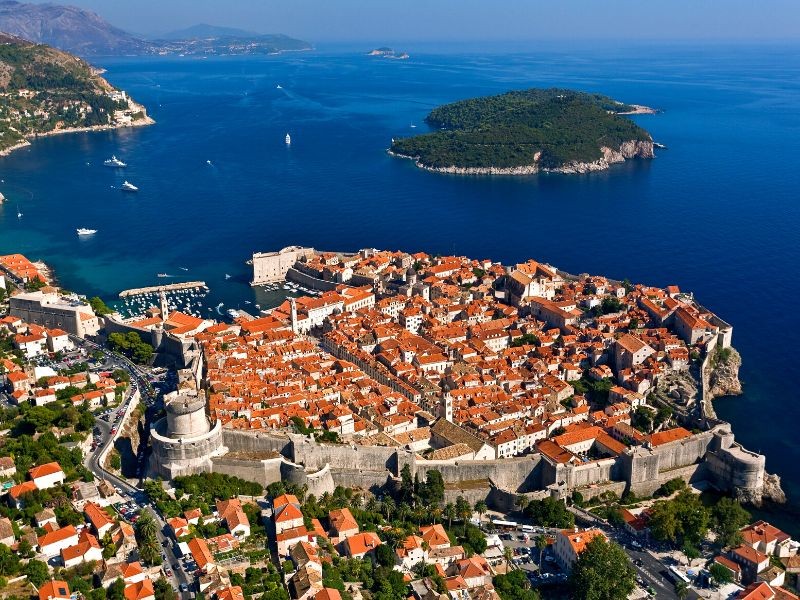
A walled, sea-battered city lying at the foot of a grizzled mountain, Dubrovnik is Croatia’s most popular tourist destination, and it’s not difficult to see why. An essentially medieval town reshaped by Baroque planners after the earthquake of 1667, Dubrovnik’s historic core seems to have been suspended in time ever since. Set-piece churches and public buildings blend seamlessly with the green-shuttered stone houses, forming a perfect ensemble relatively untouched by the twenty-first century. Dubrovnik’s charm is seen in all of its corners, filled with history, picturesque streets, squares, and steep alleyways that lead to unparalleled views. International tourism has certainly taken note, exposing the ins and outs of this jewel to help rank it as one of Croatia’s most visited harbors.
Perfect to visit when in Dubrovnik:
- City Walls guided Tour - anybody visiting Dubrovnik should be sure to explore every nook of the city’s world-famous walls and old town. Since Game of Thrones showcased the city’s fabulous architecture visitors have flocked to Dubrovnik to see “King’s Landing”, “Qarth” and the gardens of the “Red Keep” in real life.
- Explore the center of the town - visit Dubrovnik’s Cathedral, Lovrijenac fort, St. John’s fortress, Franciscan Monastery, Sponza Palace, and Orlando’s Column.
- Cable car - undoubtedly the best view of Dubrovnik can be had from the crest of Mount Srđ, which looms 412 meters above the city a short way inland.
- Trsteno Arboretum - this lovely park on a hillside next to the sea is from the 1400s, making it one of the region’s oldest arboretums. Dubrovnik’s role as a center of trade furnished the arboretum with tree species from around the world.
DAY 7. Dubrovnik
Finishing the charter waking up in Dubrovnik after a fantastic week of sailing along the Croatian coast. Disembarking from the yacht and going home filled with memories that will be remembered for a lifetime!
Now, all that’s left to do is book a yacht, relax and enjoy. Get in touch with Otium Yachts today and let’s talk about creating YOUR perfect sailing holiday.
